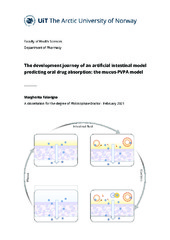Blar i forfatter "Falavigna, Margherita"
-
The development journey of an artificial intestinal model predicting oral drug absorption: the mucus-PVPA model
Falavigna, Margherita (Doctoral thesis; Doktorgradsavhandling, 2021-04-23)Oral drug administration is the most convenient route to systemically deliver drugs because of its cost-effectiveness, ease of administration and high patient compliance. However, when a drug is orally administered it will be exposed to the different physiological processes and environments found along the gastrointestinal (GI) tract, which will determine its ability of being absorbed and reach the ... -
Impact of mucin on drug diffusion: Development of a straightforward in vitro method for the determination of drug diffusivity in the presence of mucin
Falavigna, Margherita; Stein, Paul C.; Flaten, Gøril Eide; Di Cagno, Massimiliano Pio (Journal article; Tidsskriftartikkel; Peer reviewed, 2020-02-17)Mucosal drug delivery accounts for various administration routes (i.e., oral, vaginal, ocular, pulmonary, etc.) and offers a vast surface for the permeation of drugs. However, the mucus layer which shields and lubricates all mucosal tissues can compromise drugs from reaching the epithelial site, thus affecting their absorption and therapeutic effect. Therefore, the effect of the mucus layer on drug ... -
Mimicking regional and fasted/fed state conditions in the intestine with the mucus-PVPA in vitro model: The impact of pH and simulated intestinal fluids on drug permeability
Falavigna, Margherita; Klitgaard, Mette; Steene, Erik; Flaten, Gøril Eide (Journal article; Tidsskriftartikkel; Peer reviewed, 2019-02-27)Intestinal drug absorption following oral administration can be influenced by regional conditions (absorbing surface area, bacterial flora, motility, pH, mucus thickness) and food intake, all of which affect drug solubility and permeability. Therefore, it is crucial to assess the impact of these conditions on the drugability of drugs and formulations. In this study, the ability of the liposome-based ... -
Mucus-PVPA (mucus Phospholipid Vesicle-based Permeation Assay): An artificial permeability tool for drug screening and formulation development
Falavigna, Margherita; Klitgaard, Mette; Brase, Christina; Ternullo, Selenia; Skalko-Basnet, Natasa; Flaten, Gøril Eide (Journal article; Tidsskriftartikkel; Peer reviewed, 2017-12-26)The mucus layer covering all mucosal surfaces in our body is the first barrier encountered by drugs before their potential absorption through epithelial tissues, and could thus affect the drugs’ permeability and their effectiveness. Therefore, it is of key importance to have in vitro permeability models that can mimic this specific environment. For this purpose, the novel mucus phospholipid vesicle-based ... -
Novel in situ gel-forming solid dosage form (gfSDF) prepared by the simple syringe-based moulding: A screening study
Falavigna, Margherita; Skalko-Basnet, Natasa; Cavallari, Cristina; Pini, Andrea; Luppi, Barbara; Di Cagno, Massimiliano Pio (Journal article; Tidsskriftartikkel; Peer reviewed, 2017-05-05)The aim of this study was to prepare and optimize a novel type of in situ gel-forming solid dosage form (gfSDF) to be used in the treatment of mucosal/skin ulcerations. For this purpose, a simple but reliable syringe-based hot melt/moulding method was employed. Chloramphenicol (antibiotic) and ibuprofen (anti-inflammatory) were chosen as model active pharmaceutical ingredients (APIs) to be loaded ... -
Predicting oral absorption of fenofibrate in lipid-based drug delivery systems by combining in vitro lipolysis with the mucus-PVPA permeability model
Falavigna, Margherita; Klitgaard, Mette; Berthelsen, Ragna; Mullertz, Anette; Flaten, Gøril Eide (Journal article; Tidsskriftartikkel; Peer reviewed, 2020-09-08)The aim of this work was to develop a new in vitro lipolysis-permeation model to predict the in vivo absorption of fenofibrate in self-nanoemulsifying drug delivery systems (SNEDDSs). More specifically, the in vitro intestinal lipolysis model was combined with the mucus-PVPA (Phospholipid Vesicle-based Permeation Assay) in vitro permeability model. Biosimilar mucus (BM) was added to the surface of ... -
Simultaneous assessment of in vitro lipolysis and permeation in the mucus-PVPA model to predict oral absorption of a poorly water soluble drug in SNEDDSs
Falavigna, Margherita; Brurok, Sunniva; Klitgaard, Mette; Flaten, Gøril Eide (Journal article; Tidsskriftartikkel; Peer reviewed, 2021-01-21)The prediction of the <i>in vivo</i> performance of self-nanoemulsifying drug delivery systems (SNEDDSs) is currently gaining increasing attention. Therefore, the need for reliable <i>in vitro</i> models able to assess the drug solubilization capacity of such formulations upon <i>in vitro</i> lipolysis, as well as to concomitantly evaluate <i>in vitro</i> drug permeation, has become ever so evident. ... -
The Vaginal-PVPA: A Vaginal Mucosa-Mimicking In Vitro Permeation Tool for Evaluation of Mucoadhesive Formulations
Falavigna, Margherita; Pattacini, Martina; Wibel, Richard; Sonvico, Fabio; Skalko-Basnet, Natasa; Flaten, Gøril Eide (Journal article; Tidsskriftartikkel; Peer reviewed, 2020-06-19)Drug administration to the vaginal site has gained increasing attention in past decades, highlighting the need for reliable in vitro methods to assess the performance of novel formulations. To optimize formulations destined for the vaginal site, it is important to evaluate the drug retention within the vagina as well as its permeation across the mucosa, particularly in the presence of vaginal fluids. ... -
WIND-PVPA: Water/Ion NMR Detected PVPA to assess lipid barrier integrity in vitro through quantification of passive water- and ion transport
Rainsford, Philip Ben; Sarre, Birta R.; Falavigna, Margherita; Brandsdal, Bjørn Olav; Flaten, Gøril Eide; Jakubec, Martin; Isaksson, Johan Mattias (Journal article; Tidsskriftartikkel; Peer reviewed, 2022-03-22)Water/Ion NMR Detected – Phospholipid Vesicle Permeability Assay (WIND-PVPA), is presented as a novel, straightforward and automatable method to assess lipid barrier integrity in vitro. The apparent permeability constants of water- and ions across the PVPA barriers are determined in a one-pot experiment under the influence of membrane-active guest molecules. NMR spectroscopy is used to quantify ...


 English
English norsk
norsk







